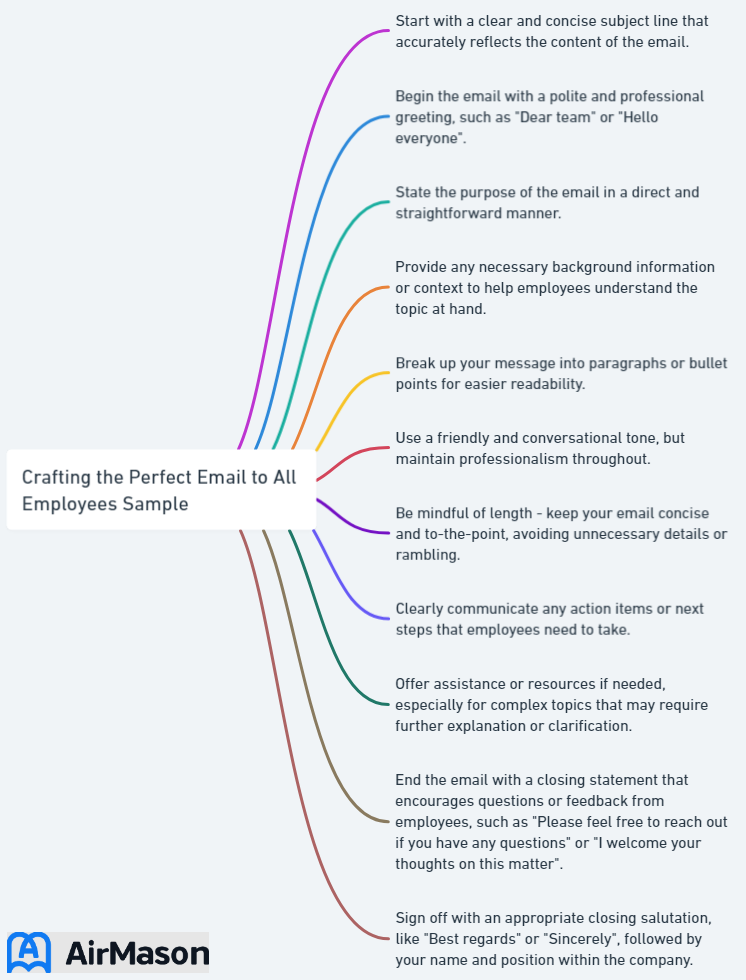
In today’s fast-paced corporate world, effective communication is the foundation for organizational success. Crafting well-written “email to all employees sample” plays a vital role in maintaining professionalism, improving communication, and boosting employee engagement. Yet, many organizations struggle with finding the perfect balance between informative and engaging emails that resonate with their employees. This blog post will guide you through the essential components of a successful email to all employees sample, provide templates for various situations, and share tips for personalizing emails and exploring alternative communication channels to enhance employee engagement.
Key Takeaways
- All-employee emails are essential for fostering professionalism, communication and engagement.
- The key components of an effective all-employee email include a clear subject line, concise content, relevant information and a call to action.
- Strategies such as interactive content, regular updates and opportunities for feedback can help increase employee engagement through email communication.
The Importance of Effective All-Employee Emails
All-employee emails play a significant role in preserving professionalism, enhancing communication, and boosting employee engagement within an organization. Well-crafted emails make employees feel valued, leading to improved morale and better performance. For instance, when introducing a new process, providing a detailed description and links to relevant resources like human resources is beneficial. Furthermore, it’s important to address poor performance to avoid its impact on the entire team and the organization’s overall performance.
Using email templates can help ensure that your internal emails are engaging, informative, and consistent. These templates can be tailored to suit specific situations, such as policy changes, company events, or performance feedback. This approach not only saves time but also guarantees that the same level of professionalism and clarity is maintained across all internal communications.
Effective all-employee emails also hinge on gathering valuable employee feedback. Encouraging employees to provide their honest opinions and suggestions can lead to improved processes and increased engagement. By creating a culture of open communication and feedback, organizations can keep employees engaged and ensure everyone is on the same page.
To sum up, well-written emails to all employees are key in maintaining professionalism, enhancing communication, and driving employee engagement. Utilizing email templates and addressing specific employee needs can greatly enhance the effectiveness of your internal email communication efforts.

Welcome in the Team
We are thrilled to extend a warm welcome in the team to our newest member. Your presence here marks the beginning of an exciting journey together. “Welcome in the team” encapsulates our collective sentiment as we embrace fresh perspectives and diverse experiences. It is our belief that each individual brings a unique set of skills and talents that enriches our collaborative efforts. With your arrival, we anticipate a dynamic infusion of creativity, dedication, and a fresh outlook that will undoubtedly contribute to our collective success. As you embark on this new chapter, know that you are not only joining a team but becoming an integral part of a larger family where mutual support and growth are at the heart of everything we do. Once again, “welcome in the team,” and may your time here be filled with meaningful contributions and rewarding experiences.
Key Components of an All-Employee Email

An effective all-employee email should comprise:
- A clear subject line
- Concise content
- Pertinent information
- An invitation to take action
A professional greeting, such as addressing each employee by name or using a formal statement like “To whom it may concern,” sets the tone for the email and is of utmost importance. Having a goal with each email provides a sense of purpose for both the sender and the reader, ensuring that emails are not sent without intent and keeping employees engaged.
The following subsections further explore these key components, offering valuable insights and examples to assist in crafting compelling all-employee emails that resonate with your workforce.
Subject Line
A compelling subject line is crucial for capturing employees’ attention and ensuring they open and read the email. To create an engaging subject line, you can highlight a few skills or achievements of the employees, or address a specific announcement or update relevant to the entire team. For example, subject lines such as “Management Change [Company’s Name]”, “Company Wide Training on [date] at [time]”, or “[Company’s Name] [Month] Newsletter” are designed to address the whole team and convey pertinent information.
Including noteworthy updates or relevant information in the subject line, like “news earlier surprised,” can pique employees’ interest, prompting them to open and read the email. Remember, an attention-grabbing subject line is the first step towards effective all-employee email communication.
Concise Content
Brevity in email content aids in message comprehension, minimizes miscommunication risk, and promotes work-life balance by preventing overwhelming employees with lengthy emails. Concise email content enhances communication in a corporate setting by:
- Maintaining the message succinct and pertinent
- Diminishing the possibility of misinterpretation or disarray
- Economizing time
- Establishing a standard for organizational structure
- Exhibiting gratitude for the recipient’s time and consideration, even when they receive negative feedback.
Generally, a concise all-employee email should comprise between 25 and 125 words or 1 to 8 sentences, ensuring that the email is succinct and direct. Maintaining brief and direct email content enables employees to grasp the message quickly and take the necessary actions.
Relevant Information
Including only relevant information in all-employee emails ensures that employees receive the necessary details without being overwhelmed by unnecessary content. Pertinent information in an all-employee email entails:
- A precise and succinct subject line
- Necessary details regarding the message or announcement
- Any action steps or expectations for employees
- Links to supplementary resources if necessary
It is imperative to furnish all the information employees need to comprehend their role and any alterations or updates being conveyed.
For example, when congratulating new employees or addressing a specific announcement, you can effectively communicate the necessary details without overwhelming your workforce by:
Including supplementary information about the message
Delineating any action steps or expectations for employees
Supplying links to extra resources if necessary
By including only relevant information in your all-employee emails, you can effectively communicate the necessary details without overwhelming your workforce.
Call-to-Action

A clear call-to-action is an essential component of an all-employee email, as it encourages employees to fulfill a task, such as responding to the email or completing a survey. Examples of calls-to-action in email templates include asking employees to respond by a specific date or complete an attached survey. Including a call-to-action can help ascertain whether each employee has received the email and prompt them to take the desired action.
In certain situations, such as announcing a training program or implementing a new process, a distinct call-to-action is crucial for ensuring that employees react promptly. By incorporating clear and concise calls-to-action in your all-employee emails, you can effectively guide your workforce towards the desired outcome.
Letter for Hiring New Employee
A well-crafted letter for hiring a new employee is a crucial component of the recruitment process. This letter serves as an official document that outlines the terms and conditions of employment, welcomes the candidate to the organization, and provides essential information about their role, responsibilities, and compensation. It is an opportunity for the hiring company to convey enthusiasm about the new addition to the team while also setting clear expectations.
In a letter for hiring a new employee, it is essential to include details such as the start date, work hours, reporting structure, and any specific requirements or documentation needed before the commencement of employment. Additionally, the letter should express confidence in the candidate’s abilities and highlight the organization’s commitment to their professional growth and success within the company.
Email Templates for Various Situations

Utilizing email templates for different scenarios can save time and ensure consistency in communication. There are four distinct types of internal email templates:
- Policy change
- Company event
- Performance feedback
- General communication
These templates can be customized by a project manager to suit specific situations, such as introducing a new project to a team, addressing employee performance issues, thanking employees at the end of the year, sending a survey, sending an alert, or announcing a company event.
Using email templates not only streamlines the process of drafting all-employee emails but also guarantees that the same level of professionalism and clarity is maintained across all internal communications. It is essential to periodically request feedback from employees and assess each situation individually, considering a personal chat instead of an email for new employees or those undergoing training.
Using email templates tailored to different scenarios can bolster the effectiveness of your internal email communication efforts.
Tips for Personalizing All-Employee Emails

Personalizing all-employee emails can increase engagement and make employees feel valued. Some strategies for personalizing all-employee emails include:
- Utilizing surveys to gather relevant information about employees
- Tailoring the content of the emails based on their preferences and interests
- Personalizing the subject lines of the emails to grab the attention of the recipients and make them feel more engaged.
Another useful approach is to employ subscriber tags to segment the employee email list and send targeted messages to specific groups based on their roles, departments, or interests. Implementing behavior-triggered emails that are automatically sent based on specific actions or events, such as completing a training program or reaching a milestone, can also help personalize email communication.
Incorporating these personalization strategies can help establish a deeper connection with your employees and cultivate a sense of belonging within the organization.
Strategies for Increasing Employee Engagement Through Email Communication

Implementing strategies such as:
- Interactive content, such as polls, surveys, and quizzes, can stimulate employee engagement, promote creative thinking, and facilitate the exchange of information.
- Regular updates can keep employees informed and engaged with the latest news and updates.
- Providing opportunities for feedback allows employees to share their thoughts, ideas, and concerns, fostering a sense of involvement and ownership.
These strategies can help improve employee engagement through email communication.
By periodically sharing company updates and news, you can keep employees informed and engaged with the organization’s goals and progress. Opportunities for feedback are also crucial for employee engagement. Encouraging employees to provide their honest opinions and suggestions can lead to improved processes and increased engagement. Creating a culture of open communication and feedback can keep employees engaged and ensure that everyone is on the same page.
Applying these strategies can fruitfully augment employee engagement through email communication and create a more connected and collaborative work environment.
Handling Sensitive Topics in All-Employee Emails

When addressing sensitive topics in all-employee emails, it’s important to be empathetic, transparent, and considerate of employees’ feelings and concerns. Here are some guidelines to follow:
- Be empathetic and understanding in your communication.
- Be transparent about the situation and provide as much information as possible.
- Avoid being overly demanding or appearing irate when giving negative feedback.
- Express a willingness to improve and work together to find solutions.
- Specify that feedback will remain anonymous if requested, allowing employees to feel comfortable providing honest feedback.
By following these guidelines, you can effectively address sensitive topics in all-employee emails.
In situations such as employee terminations or departures, a personal touch can make a significant difference. Approaching these matters with genuine concern, appreciation for their contributions, and dedication to a collaborative work environment can help alleviate any negative emotions and maintain a positive atmosphere within the organization. Implementing employee recognition strategies can further enhance this positive environment.
Always consider consulting with your HR team to ensure compliance with company policies and procedures before sending emails addressing sensitive topics. By handling sensitive topics in all-employee emails with empathy and consideration, you can maintain a supportive and understanding work environment.
Monitoring and Improving All-Employee Email Effectiveness

Regularly evaluating the effectiveness of all-employee emails and making necessary adjustments can help improve communication and employee engagement. Monitoring the efficacy of all-employee emails can include assessing employee productivity, recognizing any problematic clients or internal contacts, appraising employee performance, and guaranteeing compliance and security. Utilizing metrics such as engagement rate, unique email open rate, total email opens, click rate, total link clicks, unsubscribe rate, and conversion rate can provide valuable insights into the success of your all-employee emails.
To improve communication within the workplace, consider building trust, engaging in active listening, and ensuring clarity of expectations among employees. Monitoring and enhancing the effectiveness of your all-employee emails can contribute to a more engaged and productive workforce.
Alternative Communication Channels for Employee Engagement

While email is a valuable tool for employee communication, exploring alternative channels such as instant messaging, video conferencing, and social media platforms can further enhance employee engagement. Real-time messaging and collaboration platforms can facilitate quick and efficient communication between team members, while video conferencing and virtual meeting software can provide face-to-face interaction and foster stronger relationships among employees.
Enterprise social networks and internal collaborative platforms can offer additional opportunities for employees to connect and share information. Employee newsletters and creative methods such as:
- video AMA sessions
- digital noticeboards
- countdown clocks
- teaser campaigns
By implementing initiatives that encourage work life balance, companies can further engage employees and promote a sense of community within the organization.
Leveraging alternative communication channels for employee engagement can boost engagement, foster collaboration, and promote a more unified workplace.
New Employee Meet and Greet Invitation
The “New Employee Meet and Greet Invitation” is a pivotal moment in fostering a warm and inclusive work environment. It marks the commencement of a new professional journey and provides an excellent opportunity for both seasoned and fresh team members to connect on a personal level. This invitation serves as a catalyst for building camaraderie and establishing a sense of belonging within the organization. It not only introduces the latest addition to the team but also reinforces the values of collaboration and mutual support. The event is carefully curated to encourage open conversations, allowing individuals to share their experiences and insights, ultimately paving the way for stronger teamwork and enhanced productivity. We believe that extending this invitation exemplifies our commitment to a culture of unity and growth, ensuring that every employee feels valued and welcomed from the very beginning.
Summary
In conclusion, crafting effective all-employee emails is crucial for maintaining professionalism, improving communication, and boosting employee engagement within an organization. By focusing on key components such as a clear subject line, concise content, relevant information, and a call-to-action, you can create compelling emails that resonate with your workforce. Utilizing email templates for various situations and personalizing your emails can further enhance their effectiveness.
As you continue to improve your all-employee email communication efforts, don’t be afraid to explore alternative communication channels and implement strategies for increasing employee engagement. By fostering a culture of open communication and continuous improvement, you can create a more connected, engaged, and productive workforce.
Frequently Asked Questions
How do you write an email to all employees?
To write an effective email to employees, ensure a clear and concise subject line, lead with the most important information, maintain transparency, positivity and consistency in communication, reflect your brand and organizational culture, and make sure that the email is well written and proofread.
How do you write an email to share information to team?
To write an effective email to your team, make sure to use a professional email address, write a concise yet informative subject line, include proper salutation, be polite and choose your words carefully, provide clear information in the body of the email, end with a sign-off and signature, proofread the email, check the recipient fields, and finally send it at the right time.
What are the essential elements of an all-employee email?
An all-employee email should contain a clear subject line, concise content, pertinent information, and a call-to-action for readers.
What are some examples of effective subject lines for all-employee emails?
Effective subject lines for all-employee emails include “Management Change [Company’s Name]”, “Company Wide Training on [date] at [time]”, and “[Company’s Name] [Month] Newsletter”.
How can I personalize all-employee emails to increase engagement?
Personalize all-employee emails by utilizing surveys to gather information about employees, tailoring the content based on their preferences and interests, and personalizing subject lines to grab their attention. This will help increase engagement among employees.